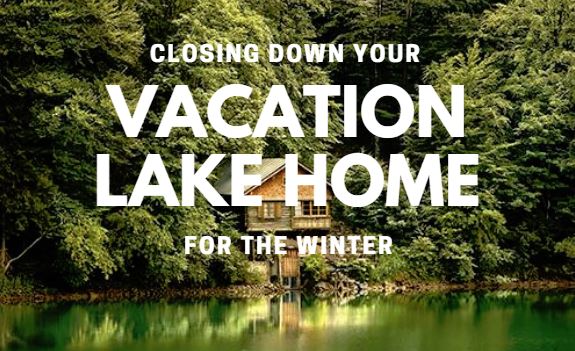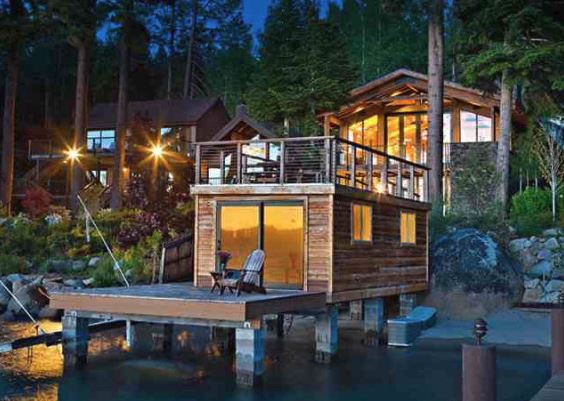
Owning a vacation lake home is, for most people, a dream come true. But now you have to sustain that dream, and that means protecting it even when you are not there. When vacation’s over, it’s time you close up for the season. So what should you do to ensure that when your family returns months, or even a year, later you won’t find a nightmare waiting?
If anything is certain about a lake home—or about any home, for that matter—it’s the fact that you can’t just walk out the door and leave the place empty for months without having first taken some precautions. So be prepared to spend a few hours getting it ready before you and the family leave; your efforts will maintain the home’s value and ensure its continued enjoyment.
The closing of a vacation home and the closing of your permanent home differ only in the specifics; that is, a bit of extra work may be required if the lake home is subject to different climatic or weather conditions. But just how much extra work depends on your own comfort level and how much you’re willing to do.
To start the closing process, look carefully around the exterior and interior of your lake home and decide what has to be done. Then write it all down to create a checklist. This essential “plan of action” will also come in handy when it’s time to open the place again, because without it, you probably won’t be able to remember all the things that have to be  “un-done.”
“un-done.”
To help you develop your own checklist, the following suggestions, though not applicable in every case, identify potential problem areas that warrant consideration:
The Kitchen
All foods should be removed so they don’t lure rodents and insects. Dry foods that remain should be locked in tin- or aluminum-lined cupboards or cabinets, and seeds and grains should be stored in metal containers with screw-on lids.
The refrigerator and freezer should be cleaned thoroughly and their doors propped open, the better to forestall mold and mildew (which like to grow in the dark) and their odors, which may transfer to the refrigerator’s plastic parts.
You may have to turn off the ice-maker and loosen refrigerator bulbs. To further thwart odors, place an open bag of charcoal on the inside of the open refrigerator.
Wash kitchen trash containers and put away soap, sponges, candles and other possible sources of food for vermin. Spray a long-lasting insecticide along baseboards and under the sink. Place insect traps under the sink and on kitchen counters and use chemical rodent deterrents under the sink and in the garage, too.
In areas subject to freezing, remove all bottled liquids, such as mineral water, soda, beer and paint, because their containers may burst when their contents freeze. Empty water from jars, vases and decorative indoor mini-fountains.
Plumbing
In areas normally not subject to freezing, turn off the main water supply—if the furnace should fail on a very cold day, water in a pipe could freeze and burst the pipe. Close sink and tub drains.
If a house is to be vacant for a long time, you may prevent water in a toilet’s trap from evaporating (and thereby permitting sewer gases to enter the home) by raising the toilet’s lid and seat and covering the bowl with saran wrap.
In areas subject to freezing, turn off the main water-supply valve or stop the pump. Open all faucets and drain all waterlines—empty or mainly empty pipes cannot burst from freezing water. Pipes can be drained at their low-point drain valves or, if there is insufficient slope to the lines, by opening a pipe junction.
For sinks, washtubs, showers, toilets and hot tubs, pour some kerosene or auto antifreeze slowly down their drains to replace the water in their traps; this will also keep sewer gases from entering the house. Close sink and tub drains.
Drain the water storage tank and consult a neighbor or local plumber to learn if the septic system should also be drained. Turn off the hot-water heater before you drain it. Drain water from a pump by using its drain plug. For electric dishwashers and clothes washers, follow the manufacturer’s directions. If you find the task daunting, get a local plumber to do it for you.
Utilities
Some experts suggest turning off electric power completely but this depends solely on local conditions. For example, in a region subject to freezing you may elect to leave the heating system on but at a lower temperature to avoid frost damage to the home’s interior and its contents. If you use an electronic alarm system, then continuous electric power is required (apart from back-up batteries).
If you leave the electric power on, unplug electric appliances, including microwave ovens and TVs, to avoid the risk of fire in the event of a faulty switch or a rodent gnawing the wires. Set your thermostat to a level adequate to keep the inside temperature above freezing and to keep things dry. If the home is located in a warm, damp climate, you should have a humidistat installed and set to maintain a reasonably dry interior.
If there are gas appliances in the home that have been approved by the American Gas Association, they would have automatic shutdowns that will close the gas valves if their pilot lights go out. Such appliances may be left on if properly vented, but if in doubt, check the owner’s manuals. For long absences, some experts recommend shutting off gas hot-water heaters completely.
Security
Good quality locks for your doors and windows are a must! If in a damp, humid climate, periodically lubricate pin tumbler locks with white lithium grease; using anything else will cause the mechanisms to gum up over time.
Strike plates and door hinges should be secured with wood screws at least three inches long. Close window shutters. Aside from enhancing security, shutters will, along with drapes, blinds and curtains, keep carpeting and fabrics from fading.
Stop mail and other routine deliveries. Unplug garage door openers. Trim shrubbery so doors and windows are not blocked from view. Keep ladders inside or otherwise secured. Take small valuables with you.
If an electronic alarm system is used, make certain that back-up batteries (if any) are in good condition and able to provide coverage in the event of power interruption; you may want to consider other standby power options as well. If the alarm system is monitored, don’t forget to inform the security company of your date of departure and tell them where you can be reached in an emergency. Give the same information to the local police and fire departments.
Remove all fire hazards, such as oily rags and stacked papers, before you leave. And if there is a neighbor who’ll remain in the area while you’re gone, try to work out an arrangement by which someone will come over every now and then to look the place over.
The Exterior
Check that all holes and cracks in exterior walls and foundations and around pipes that penetrate the exterior walls are sealed; otherwise they are entry points for rodents and insects. Rodents and birds can also gain entry via stovepipes and chimneys so these must be secured as well.
A #10 can (large coffee can) may be used to cap an open stovepipe (the kind that on top takes the shape of a T or an H), but a chimney should be capped with a permanent, stainless steel cap with wire mesh venting. Close flues and dampers.
Leave nothing outdoors that can be blown about by a strong wind or washed away by a lake or river overflowing its banks. If possible, cut tree limbs and branches that overhang the house—they offer rodents easy access to the home’s roof and eaves from which they have easier access to a home. Arrange to have the lawn mowed and shrubbery trimmed.
General
If linens, bedding, towels and the like remain, they should be washed or cleaned and then stored in boxes, preferably rodent-proof ones. Strip beds so mattresses can air out. Open empty drawers and closets; use mothballs in the others. Remove all trash.
Vacuum carpets and floors to ensure that no crumbs or other sources of food remain for vermin. In humid regions, use desiccants (water-absorbing material) in closets; most hardware stores sell them.
Opening the Lake Home on Your Return
Now here’s where your checklist will prove its worth. For starters, open all windows and turn on the furnace fan to air out the home. Readjust the thermostat and humidistat. Close all drain valves and plugs; open the main water valve or turn on the pump. Flush waterlines to remove traces of kerosene or antifreeze.
Uncap stovepipes and open flues and dampers. Check the interior and exterior of your home carefully for signs of rodent and/or insect infestation, mildew and fungi. Turn on gas and electric power and go down the checklist to put your home back to the way it was before you left it. And don’t forget to announce your return to everyone you had informed of your departure.
Good luck!
Posted by Scott Freerksen “The Lake Guy”
